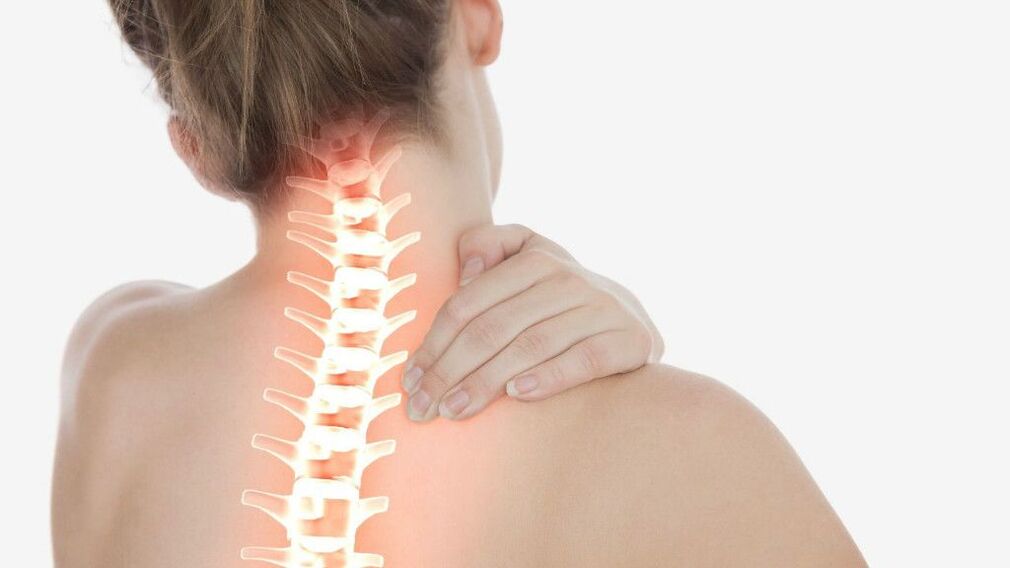Osteochondrosis of the cervical spine is a degenerative and dystrophic disease that affects the intervertebral discs of the neck.This pathology is the most common pathology of the spine.

Symptoms of the disease
Characteristic symptoms occur in the course of the disease.This includes the following manifestations:
- weakness
- dizziness
- Headache
- Noise in the ears
- Change the function of the visual organ (acceptance of its severity, flickering flickering in front of the eyes)
- Increased sensitivity in the hand
- Deafness of the hand
- Then a person in general can stop moving his hand
- Stiffness in the joints of the upper extremity
- Crunch in the neck
- A feeling of stiffness and pressure in the chest.
The causes of the disease
The most important causal factors for osteochondrosis of the cervical spine are as follows:
- Small mobility of the neck, which means that the intervertebral disc loses liquid and also leads to a loss of the elasticity of the cartilage
- Inheritance burdened the reserve of the strength of the intervertebral disc
- Microtaumatization of the cervical spine with sharp curves, tipping the head, etc.
- Metabolic disorders that negatively influence the condition of the cartilage in the intervertebral disc.
Diagnosis
The diagnostic search for osteochondrosis of the cervical spine includes the following studies:
- X -Ray
- Computed tomography
- Nuclear-magnetic response
- Electromyography.
Each of the above studies contains certain diagnostic information.The first three enable them to identify changes directly in the spine that are characteristic of osteochondrosis.The latest study enables you to diagnose complications of osteochondrosis, which consist of damage to the nerve trunks.
An X beam examination is carried out at different levels, and sights are also carried out for a more precise detail of characteristic changes.This study shows that calculation in the tape apparatus of the spine, a change in the height of the intervertebral discs, the deformation of the cervix region, etc.
Computer tomography and nuclear magnetic resonance enable you to obtain the most reliable information.It is therefore recommended to use them in complex diagnostic cases.
Electromyography examines the conductivity in nerve fibers, which is very often reduced with osteochondrosis of the cervical spine.This is due to the fact that with a decrease in the height of the intermediate disks, the conditions for compression of nerve roots are generated.Therefore, such clinical symptoms such as increased sensitivity, parese and paralysis occur.
Complications
The lack of timely treatment of osteochondrosis of the cervical spine can lead to the development of the following complications:
- Paralese and paresis of the upper extremity on one or two sides
- Ischemic hub of the brain.
Treatment of the disease
The goals that the treatment of osteochondrosis pursues are as follows:
- Reduction of the severity of pain syndrome
- Prevention of progression pathological changes.
The following methods are used to implement these goals:
- Manual therapy is carried out
- acupuncture
- Medical physical education
- gymnastics
- Bathe.
The purpose is shown in parallel:
- Chondroprotectors who can increase the cartilage resistance and recover
- Non -steroidal anti -inflammatory medication that reduces the severity of the pain.
Unique treatment methods
- Applied kinesiology
This is a method for diagnosing and treating diseases of the spine, the joints and the nervous system based on muscle tests.The doctor examines the condition of tissues and organs.
- Treatment with leeches
Together with a leech bite, around 100 biologically active components arrive in human blood.This helps to clean blood vessels, to eliminate blood clots and to disturb their formation.
- Reflex zone massage
Acupuncture helps osteochondrosis, radiculitis and other diseases of the spine and joints.The process relieve pain, heal the body and strengthen immunity.
Risk group
The following categories of people must be included in the risk group:
- With polluted inheritance
- Maker
- Have background pathological processes.
prevention
Preventive measures to prevent osteochondrosis of the spine are as follows:
- Correct attitude during sitting
- Change of loads and calm
- Exclusion of weight weights (in this case it is better to give a backpack preference)
- Regular medical examinations for a neurologist and orthopedic surgeon for the early detection of osteochondrosis of the cervical spine.
Diet and lifestyle
With osteochondrosis, it is necessary to make certain adaptations to the lifestyle.You are as follows:
- Treatment of the pathological procedure of the background, which led to osteochondrosis when it was demonstrated
- Exception of the weighting
- Normalization of nutrition - rejection of fat, fried, acute, salty, increase the content of plant fibers and products with chondroitine (jelly, jelly) in the diet
- A sufficient pace of physical activity.





















